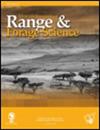Participatory inventory and nutritional evaluation of local forage resources for smallholder free-range beef production in semi-arid areas of South Africa
IF 1.9
4区 环境科学与生态学
Q3 ECOLOGY
引用次数: 3
Abstract
Feed scarcity is a major challenge facing free-range beef farming in semi-arid areas. Specifically, low quality and quantity of forage in rangelands and higher feeding costs are the main constraints limiting smallholder free-range beef farmers’ participation in mainstream beef markets. Using farmers’ participatory approaches, this study identified major locally available forage resources (LAFRs) and evaluated their nutritional value. A total of 40 free-ranging commercially orientated smallholder beef farmers were interviewed using semi-structured questionnaires and tasked to identify LAFRs in the Cradock and Middelburg areas of the Eastern Cape, South Africa. Chemical analysis was conducted for the most cited forages such as African sheepbush (Pentzia incana), sweet thorn (Vachellia karroo) leaves and pods, reed (Phragmites australis), lucerne (Medicago sativa) hay, natural pasture grasses (NPGs) and barbary fig, or prickly pear cactus, (Opuntia ficus-indica) cladodes collected from twelve participants’ farms. Feed shortage was ranked by more than 53% respondents as the main constraint to smallholder beef production. Regardless of the farming area, crude protein content of V. karroo leaves and pods averaging 18.8 and 19.5%, respectively, was higher than other LAFRs. However, V. karoo pods had relatively low ash content than other forages in both farming areas. Opuntia ficus-indica attained high in vitro neutral detergent fibre digestibility at 12, 24 and 48 hr incubation periods, due to low neutral detergent fibre, acid detergent fibre and acid detergent lignin. Integration of participatory inventory and chemical analysis proved to be reliable in identifying LAFRs, with V. karroo leaves and O. ficus-indica cladodes being the main potential forage resources for inclusion in beef cattle diets. Further research is recommended to substantiate their supplementary nutritive value and level of inclusion in beef cattle finishing diets.南非半干旱地区小农散养牛肉生产的当地饲料资源参与性清查和营养评价
饲料短缺是半干旱地区散养牛肉养殖业面临的主要挑战。具体而言,牧场牧草的质量和数量较低以及饲养成本较高是限制小农散养肉牛养殖户参与主流牛肉市场的主要制约因素。采用农民参与的方法,本研究确定了主要的当地可利用饲料资源(LAFRs),并评估了其营养价值。使用半结构化问卷对40名自由放养的商业肉牛小农进行了访谈,并确定了南非东开普省克拉多克和米德尔堡地区的lafr。对从12个参与者的农场收集的最常被引用的牧草进行了化学分析,如非洲羊灌木(Pentzia incana)、甜刺(Vachellia karroo)的叶子和豆荚、芦苇(Phragmites australis)、苜蓿(Medicago sativa)干草、天然牧草(npg)和无花果或仙人掌枝(Opuntia ficus-indica)。超过53%的受访者将饲料短缺列为小农牛肉生产的主要制约因素。在不同的养殖区域,柠条叶片和豆荚的粗蛋白质含量平均分别为18.8%和19.5%,高于其他LAFRs。然而,在两个农区,鹿茸豆荚的灰分含量相对较低。由于中性洗涤纤维、酸性洗涤纤维和酸性洗涤木质素含量较低,在培养12、24和48小时时,无花果麻获得了较高的体外中性洗涤纤维消化率。参与性调查和化学分析相结合的方法被证明是鉴定lafr的可靠方法,其中甘露叶和无花果叶是肉牛日粮中主要的潜在饲料资源。建议进一步研究以证实其补充营养价值和在肉牛育肥期日粮中的添加水平。
本文章由计算机程序翻译,如有差异,请以英文原文为准。
求助全文
约1分钟内获得全文
求助全文
来源期刊

African Journal of Range & Forage Science
ECOLOGY-ENVIRONMENTAL SCIENCES
CiteScore
4.00
自引率
14.30%
发文量
35
审稿时长
>12 weeks
期刊介绍:
The African Journal of Range & Forage Science is the leading rangeland and pastoral journal in Africa. The Journal is dedicated to publishing quality original material that advances rangeland ecology and pasture management. The journal aims to publish research of international importance from any region, but as an African journal, we are particularly interested in research from Africa and relevant to the continent. The Journal promotes both science and its application and authors are encouraged to explicitly identify the practical implications of their work. Peer-reviewed research papers and research notes deal primarily with all aspects of rangeland and pasture ecology and management, including the ecophysiology and biogeochemistry of rangelands and pastures, terrestrial plant–herbivore interactions (both domestic and wild), rangeland assessment and monitoring, effects of climate change on rangelands, rangeland and pasture management, rangeland rehabilitation, ecosystem services in support of production, conservation and biodiversity goals, and the identification and development of intensive and semi-intensive pasture and forage resources to meet livestock production needs. Articles highlighting transdisciplinary linkages among biophysical and social sciences that support management, policy and societal values are particularly encouraged. The Journal includes relevant book reviews and invited perspectives that contribute to the development of range and forage science. Letters to the editor that debate issues raised in the Journal are acceptable. The African Journal of Range & Forage Science is the official journal of the Grassland Society of Southern Africa.
 求助内容:
求助内容: 应助结果提醒方式:
应助结果提醒方式:


